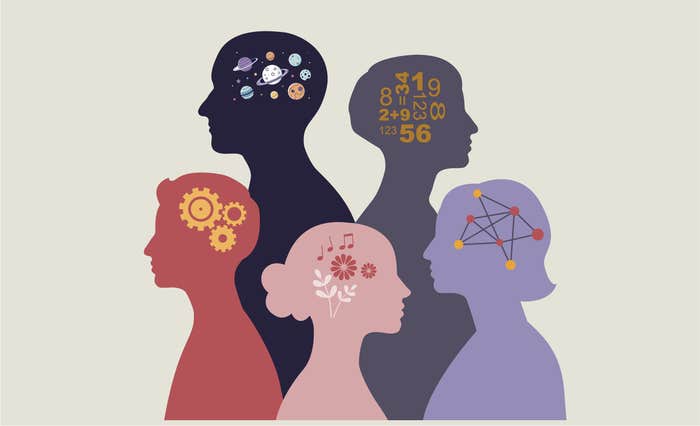It doesn’t seem enough to call Stephen Paddock, who killed 58 innocent people in Las Vegas this month, a monster. The term has lost its power to evoke the unimaginable. The beasts that terrorized the mental lives of our ancestors have been tamed by religion and culture, notes Stephen T. Asma this week in a Nautilus essay, “Why Are So Many Monsters Hybrids?”. So what do we call Paddock?
Asma, a professor of philosophy at Columbia College Chicago, and author, most recently, of On Monsters and The Evolution of Imagination, says the term “monster” is not ready to be retired. The moniker suits Paddock, he says. “Monster is a term we reserve for people who cannot be negotiated with. It’s almost impossible, if not impossible, to understand their behavior, their motives, their mind. Our regular theory of mind doesn’t work on these people.”

In a ranging interview with Nautilus about mythic and real monsters, Asma talked about the evolutionary origin of werewolves and the psychological fears that give rise to tyrannous leaders. Asma lived in Cambodia for a while and learned about the monstrous rule of Pol Pot. He offered his view of what appeals to Americans about Donald Trump. We delved into the roles that desire and repulsion play in our conceptions of monsters, and why he disagrees with neuroscientist Lisa Feldman Barrett about the source of emotions.
Given the strange and gruesome tales in his chosen field of study—“You definitely want to wait until you have tenure before you write a book on monsters,” the philosophy professor says wryly—Asma was invariably amiable in conversation. He is the cheerful amanuensis of humanity’s darkest fears.
What is a monster?
It’s from a Latin word, monstrare, to warn. If you look at early uses of the term and concept, particularly in Greek and Roman cultures, it was applied to something like a baby born as a conjoined twin or missing a limb or with extra limbs. These were thought to be monsters. The Greeks called them teratos. They thought they were horrifying punishments for immoral activity—a theme the medieval Christians jumped on and articulated. It was a sign that things were going to be bad for the state, or for this particular emperor, or this particular battle. It’s a mix of natural calamity and supernatural significance.
Are monsters a manifestation of repulsion?
Yes, there’s always an emotional or affective component to it. An interesting philosopher named Noel Carroll argues that when you look at monsters, particularly modern monsters of horror genres, you’ll see they’re oozing slime or have extra appendages and tentacles. There’s something violating our sense of bodily barriers or bodily limits. That tends to activate the disgust emotion. That’s also why monsters are so useful politically. When a culture is about to go to war it demonizes or monsterizes the other group. That requires casting them as uncivilized and disgusting. You target their sexual hygiene, for example. You target them as objects of disgust.
The term “monster” still does good work when you get to somebody like the Las Vegas killer Stephen Paddock.
So in sociological terms, monsters are the “out group”?
Right, you’re different from us. There’s a xenophobia running through the whole history of monsters. If you’re different from us, we’ll have a disgust-response or will be afraid and on guard. You see that in the ancient world. You see it through the medieval period and all the way up to the present, in the way we cast our enemies.
Did religion play a role in the concept of monsters?
Religion never just builds a pantheon of gods. It always builds the gods as the response to a threat structure, which is going to be a monster story of some kind. If you look at the earliest stories, whether it’s in Hindu, Chinese, or Mesopotamian literature, like Gilgamesh, you always confront a monster-hero or hero-monster. This must be part of an adaptive strategy for building fictive kin groups. How do you get cooperative groups among large numbers of people who aren’t blood relations? You’ve got to have these narratives.
Do monsters have an adaptive function?
From the point of view of evolution, casting others as monsters would have been extremely adaptive and helpful to your own survival as a group. Nature was not a warm and fuzzy place. Some of these horror stories were helpful in getting you to be nervous about real predators—both non-human animals and human predators. The traditional werewolf story was very strong in Europe. That makes sense because wolves in northern Europe, as they evolved, were a predator for Europeans. There’s a werebear tradition in the Americas because Native Americans were worried about real bears and violence through bear predation or bear attacks. If you look at the monsters of these ecologies or environments, you’ll see they share a transformational function. The animal that you can become, or that you should be afraid of, is the local predator.
You write there’s another side to the story. What’s that?
It’s an interesting thread that doesn’t get a lot of attention. It’s not xenophobic but xenocurious. A classic example is from St. Augustine. He knows monsters are supposed to be living in Africa and the East. This includes Cyclops; the cynocephali, the dog-headed men; and the blemmyes, which had no head, but their face appears in their chest. Everybody thinks these monsters are evil incarnate, the children of Cain, stake them in the heart, that’s the end of it. But Augustine stresses the “wondrous” aspects of these creatures. He says, “These guys are scary, but if we can talk to them, and they demonstrate some kind of rationality, they might be capable of being saved, they could be part of redemption.”
How’s this tradition been passed down over the years?
It’s the project of Western liberalism to increase the circles of tolerance to those who are different from you. From the modern liberal point of view, having disgust toward strangers is a terrible thing. You shouldn’t monsterize or demonize others, you shouldn’t feel disgust toward them. That’s one way to interpret Frankenstein. When they teach Frankenstein in high schools, they teach it as a way to show that you create aggression and violence by not welcoming difference into your group. It’s a liberal interpretation of the monster. The monster is not evil. What the monster needs is a hug, understanding, and rational negotiation.
When did monster become a term for a person?
That’s a really interesting issue. There’s a few threads we could trace. One is from the ancient Greeks, who had a notion of monstrous desire. You could have a desire in you that was so overwhelming that it would alienate you from yourself. The reason why Medea kills her children, the reason why this person slays that person, or love drives you insane, is because Eros made you do monstrous things. It was a possession from within. It’s a psychological ability that you failed to educate properly. I think that thread goes all the way to Freud and the idea of an id being who we are deep down. There’s a part of us all that has to be carefully managed. Otherwise it does psychopathological actions. You see this now with the Las Vegas shooter. We want to know why he did it. Is there some part of ourselves that if we don’t manage it correctly, it could, in fact, lead us to some kinds of behaviors like this?
Would you call Stephen Paddock, the Las Vegas killer, a monster?
Yes. And that’s where the term “monster” still does good work. It applies to a category of monster we can’t understand. It’s like, “I can’t even process this. This makes no sense to me.”
How does the term “monster” do good work?
A lot of people think, “Well, a monster is an old word that needs to go away entirely, and what you have to do is understand people and what makes them tick.” I’m of the view that monster just still does good work as a term when you get to somebody like Stephen Paddock. One of the things about a monster is that it’s not someone you can negotiate with rationally. You might find common ground with an enemy. Maybe your enemy hates you. Maybe it’s economically based. Monster is a term we reserve for people who cannot be negotiated with. It’s almost impossible, if not impossible, to understand their behavior, their motives, their mind. Our regular theory of mind doesn’t work on these people. Monster has negative connotations, and that has to be talked about. But in this case it’s perfectly appropriate to use it.
Do we simply have to be content with the fact that human beings can be monstrous?
It’s a hard question. I interviewed a judge who’s spent the last 30 years dealing with some of the most heinous criminals that we read about in the newspaper. The same goes for my brother, who’s an investigator for a public defender. Both have told me that when you’re interviewing somebody who’s been arrested for killing his children or some other horrible act, once you start talking with him, it becomes very hard to see them as monsters.
I remember my brother telling me about this guy who’s supposed to be a monster. After a few hours, they get onto music. It turns out they have common music tastes. Maybe they share a smoke. All of a sudden you’re in this human relation with them that is natural. That really modifies this tendency to see this person as just a monster.
I think every person is capable of committing monstrous acts, but true monsters are quite rare.
The judge made this distinction. He said, “I think their actions are monstrous, but I don’t think of the person as monstrous.” I think the law makes a further distinction. There’s a category in jurisprudence where they say, “OK, you got drunk or high on something, and been angry and then committed some horrible murder.”
There’s another category of person recognized in U.S. common law with this wonderful term, which sounds very 19th-century; they say this person has a “malignant heart.” That’s actually a legal term, since it is part of the common law definition of “malice” and appears in the California Penal Code. It means it’s a character issue. This person intends and possibly enjoys the pain of another person. I think it’s interesting the law recognizes that there’s some people who are just rotten and have to be contained. They didn’t just have a monstrous moment or commit a monstrous act. These are the monsters.
But can we separate a person from his or her actions? There’s only one brain behind both.
Yeah, these are folk categories, I guess. But folk categories often dominate in the law. On the other hand, if I just go the route of neuroscience, I can see myself quickly tipping toward determinism. If we went into somebody like Stephen Paddock’s brain, are we going to find a tumor? The fact that no other motive is popping up might make me tilt in that direction. Perhaps there was something like this. The jury’s still out. We need more information.
But you’re right: Is there a sense in which a heinous activity can’t be separated out from the person, or the person can’t be separated out from the sum of their actions? On the other hand, we do need some distinction between somebody who does something in a state of temporary loss of self control vs. somebody who is premeditating and working out in detail some nefarious act. That’s why terms like “character” still do good work in the humanities. In terms of neuroscience, yeah, there isn’t going to be a separate homunculus in the brain, but there might be some story to be told about failures of the impulse control system.
Do you think every human being is capable of being monstrous?
I think every person is capable of committing monstrous acts, but true monsters are quite rare. Our Darwinian inheritance provides all of us with adaptive forms of aggression, but the nurture of caregivers and cultural education tempers and domesticates our predatory tendencies. Failures of parenting and cultural education, together with brain anomalies, are usually in the background of psychopathic personalities. Having said that, certain ideologies like jihadism or imperialism can re-educate an otherwise compassionate person into a monster. Bad ideas can redirect our pro-social emotions, and create a malignant heart.
Who or what’s responsible for monstrous leaders?
There’s something about the tyrannical man that’s attractive to people who feel under threat, or in a body politic that feels under threat. You see this time and again. Sociologists and anthropologists call it the “big-man phenomenon.” A lot of them agree that when a group feels under threat and their basic needs are not being met, a really charismatic, tyrannical person rises to the top. You saw this with Hitler. You saw it with Stalin. I’ve lived in Cambodia and know a lot about the Khmer Rouge story and Pol Pot. But even Plato said the same thing in The Republic.
What’s interesting is it’s hard to critique, or counterweight, because the tyrant, or monstrous leader, only has to be aggressive. That’s his whole job. If you complain that he’s irrational or not making sense, or hard to cooperate with, it doesn’t matter. Those are the “virtues” of the monstrous leader. Take Donald Trump’s thing with “Little Rocket Man,” as he now calls Kim Jong-un. The appeal of Trump, I think, for his supporters, is Trump now looks crazy, and so maybe other big men, big chiefs, will recognize and respect another crazy man. This could actually have a deterrent effect. It could also be part of the explanation of why a monstrous leader stays in power.

What do you mean when you write monsters have a moral purpose?
Monsters can be part of the moral imagination as a way to define what we don’t want to be. An obvious case would be a jihadi, who cuts off the head of a journalist. But there’s also subtle permutations like Ebenezer Scrooge. Our literature and culture creates icons of immorality, and they help shape our behavior and our thinking. A lot of people enjoy horror like The Walking Dead because it’s a form of rehearsal. I’m not expecting a zombie apocalypse, but I do wonder what would happen if the grid went down and we had no electricity and suddenly there’s a food shortage. What would happen if modern society came to some screeching halt? Many of the monster scenarios would be a surrogate training for what could happen between human beings.
What is your monster?
I’m afraid of deep or murky water. It’s almost a paralyzing fear because I fear sea monsters, which is an utterly irrational and ridiculous fear. It’s made me wonder what’s going on.
So, what’s going on?
When you study philosophy, there’s this bias in the field against irrationality. Once it works out the kinks, rationality is supposed to be the great light of the psyche. It shines in and clarifies supernaturalism and irrational fears. All you have to do is train your mind well and you’ll be able to clean out the basement of the psyche using the bright light of reason. I began to realize that is just not right. Reason is not the great operating system. It is built on a much bigger and older operating system, which is the emotional operating system. There’s a lot of research showing that rational or cognitive behavioral therapy does little to help people get over real, debilitating phobias. It really appears to be something else or something deeper.
Ultimately the story of fear, phobia, and horror has to be rooted in ancient emotional systems.
What’s the seat of that paralyzing fear?
I think the full story will not be told for another decade or two, but I do think work by affective neuroscientists like the late Jaak Panksepp, Antonio Damasio, Kent Berridge, and Richard Davidson, is getting us there. These thinkers believe there’s an innate emotional wiring that is flexible enough to grab onto different things and experience. I think that view is right, although it’s currently under critique by people like Lisa Feldman Barrett. But I really disagree with her theory of constructed emotions. I think she’s way too up in the conceptual space of the mind.
Her view is emotions aren’t readymade circuits in the brain triggered by experiences. They’re constructions, the brain’s way of making sense of the world.
Yeah, and I think what she’s describing makes sense for a certain domain of mental life, namely a rarefied human domain of mental life. But I’m too much of a Darwinian about the mind to think this is how most of our emotions happen. There are more subtle kinds of emotions, the sense of angst or ennui, or other language based emotions, that might fit well with Barrett’s view. But I think, homologously, we share basic affective systems with other mammals. She denies this and that’s where I just disagree. She intellectualizes emotions so much—seeing them as concepts—that she cannot explain animal emotion or emotion in babies. Ultimately, the story of fear, phobia, and horror has to be rooted in the more ancient emotional systems.
How did monsters lead you to writing about imagination?
I’d been thinking a lot about images. Long before we had written language and stories, we had images in our brains as a result of perception. We must have been engaging in a kind of communication with images and with bodily gestures before we had language. This got me thinking about how old the imagination is. Is it something that comes along after language, or were we able to communicate with images long before we had language? I feel like there are many ways of having knowledge and communicating with others that’s non-linguistic, that has to do with body gesture, in the form of dance, or in the course of drawing or imagery, like cave paintings at Lascaux or Chauvet. There’s a whole language of the imagination and a life of the mind that preexisted propositional thinking.
Does that ancient imaginative life still exist within us?
My view is we still have it, yes. It’s obscured by the dominance of propositional thinking. We’re very executively organized in our brains now. That’s what you’re doing when you raise a kid. You’re sculpting a neocortical operating system over the mishmash of much more associational motor perceptual processes. We’re all taught how to discipline our minds just like we’re taught to discipline our behavior. But we can, in the course of creative activities like the arts, shut off that neocortical editor and take little field trips to this earlier form of mind.
What would you be if you weren’t a philosophy professor?
I’m torn because my allegiances are equally divided between music and visual art, but I would definitely be some kind of an artist. I still am an artist. I just don’t get paid much for it anymore.


























